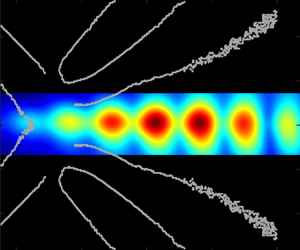Published online by Cambridge University Press: 14 July 2022

The supersonic wake of a circular cylinder in Mach 3 flow was studied through high-speed, focussing schlieren photography. The mean and unsteady behaviour of the separated shear layers, the reattachment process, the recompression wave and the early wake are analysed, and discussed in detail. The fluctuations in the wake are stronger and more coherent than those within the approaching shear layers and the recirculation region. The recompression of the shear layers energises the finer scales in the flow which leads to a departure from a  $-$1 spectral roll-off observed in the schlieren spectra further upstream. The recompression wave exhibits low-frequency unsteadiness and a ripple-type motion which occurs as it is perturbed by shocklets radiating from the coherent structures in the wake. The wake consists of coherent disturbances with the same characteristic frequency as that for an incompressible flow over a cylinder; however, this instability is suppressed as the wake accelerates, presumably due to increasing compressibility. The primary instability of the wake flow has a characteristic frequency nearly twice that of its incompressible counterpart and it is shown to be driven by the presence of aeroacoustic resonance in the wake. It is also shown that the resonance, which leads to the formation of broadband standing waves in the wake, is the result of an interaction between the wake instabilities and upstream propagating acoustic waves in the wake. The acoustic waves originate upstream of the reattachment region and are believed to be generated by the unsteady separation on the cylinder surface.
$-$1 spectral roll-off observed in the schlieren spectra further upstream. The recompression wave exhibits low-frequency unsteadiness and a ripple-type motion which occurs as it is perturbed by shocklets radiating from the coherent structures in the wake. The wake consists of coherent disturbances with the same characteristic frequency as that for an incompressible flow over a cylinder; however, this instability is suppressed as the wake accelerates, presumably due to increasing compressibility. The primary instability of the wake flow has a characteristic frequency nearly twice that of its incompressible counterpart and it is shown to be driven by the presence of aeroacoustic resonance in the wake. It is also shown that the resonance, which leads to the formation of broadband standing waves in the wake, is the result of an interaction between the wake instabilities and upstream propagating acoustic waves in the wake. The acoustic waves originate upstream of the reattachment region and are believed to be generated by the unsteady separation on the cylinder surface.